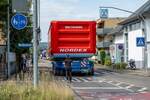NREL Advanced Manufacturing Research Moves Wind Turbine Blades Toward Recyclability
Researchers at the U.S. Department of Energy’s National Renewable Energy Laboratory (NREL), in partnership with Arkema Inc of Pennsylvania, have demonstrated the feasibility of thermoplastic resin and validated its structural integrity on a thermoplastic composite blade manufactured at NREL.
Blades are currently manufactured using thermoset resin, which requires more energy and manpower in the manufacturing facility, and the end product often ends up in landfills. Switching to thermoplastic resin would make wind turbine blades more recyclable, and can also enable longer, lighter-weight, and lower-cost blades.
“With thermoset resin systems, it’s almost like when you fry an egg. You can’t reverse that,” said Derek Berry, a senior engineer at NREL. “But with a thermoplastic resin system, you can make a blade out of it. You heat it to a certain temperature, and it melts back down. You can get the liquid resin back and reuse that.”
Berry is co-author of a new paper titled, “Structural Comparison of a Thermoplastic Composite Wind Turbine Blade and a Thermoset Composite Wind Turbine Blade,” which appears in the journal Renewable Energy.
The other authors, also from NREL, are Robynne Murray, Ryan Beach, David Barnes, David Snowberg, Samantha Rooney, Mike Jenks, Bill Gage, Troy Boro, Sara Wallen, and Scott Hughes.
NREL has also developed a technoeconomic model to explore the cost benefits of using a thermoplastic resin in blades. Current wind turbine blades are made primarily of composite materials such as fiberglass infused with a thermoset resin. With an epoxy thermoset resin, the manufacturing process requires additional heat to cure the resin, which adds to the cost and time to manufacture blades. Thermoplastic resin, however, cures at room temperature. The process does not require as much labor, which currently accounts for about 40% of the cost of a blade. The new process, the researchers determined, could make blades about 5% less expensive to make.
NREL is home to the Composites Manufacturing Education and Technology (CoMET) Facility at the Flatirons Campus near Boulder, Colorado. There, researchers design, manufacture, and test composite turbine blades. They previously demonstrated the feasibility of the thermoplastic resin system by manufacturing a 9-meter composite wind turbine blade. They followed that demonstration by manufacturing and structurally validating a 13-meter thermoplastic composite blade compared to a near-identical thermoset blade. This work, coupled with work by Arkema and other Institute for Advanced Composites Manufacturing Innovation partners, demonstrated advantages to moving away from the thermoset resin system.
“The thermoplastic material absorbs more energy from loads on the blades due to the wind, which can reduce the wear and tear from these loads to the rest of the turbine system, which is a good thing,” Murray said.
The thermoplastic resin could also allow manufactures to build blades on site, alleviating a problem the industry faces as it trends toward larger and longer blades. As blade sizes grow, so does the problem of how to transport them from a manufacturing facility.
The U.S. Department of Energy’s Advanced Manufacturing Office funded this research.
NREL is the U.S. Department of Energy's primary national laboratory for renewable energy and energy efficiency research and development. NREL is operated for the Energy Department by the Alliance for Sustainable Energy, LLC.
- Source:
- NREL
- Author:
- Press Office
- Link:
- www.nrel.gov/...
- Keywords:
- USA, NREL, manufacturing, turbine, rotor blade, blade, onshore, offshore, research, composite, study, thermoplastic composite blade, thermoset resin system, recycle























